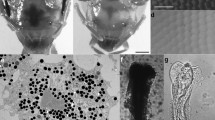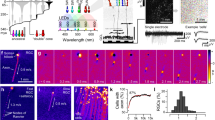Summary
The spectral sensitivity of the visual cells in the compound eye of the mothDeilephila elpenor was determined by electrophysiological mass recordings during exposure to monochromatic adapting light. Three types of receptors were identified. The receptors are maximally sensitive at about 350 nm (ultraviolet), 450 nm (violet), and 525 nm (green). The spectral sensitivity of the green receptors is identical to a nomogram for a rhodopsin with λmax at 525 nm. The spectral sensitivity of the other two receptors rather well agrees with nomograms for corresponding rhodopsins. The recordings indicate that the green receptors occur in larger number than the other receptors. The ultra-violet and violet receptors probably occur in about equal number.
The sensitivity after monochromatic adapting illumination varies with the wavelength of the adapting light, but is not proportional to the spectral sensitivity of the receptors. The sensitivity is proportional to the concentration of visual pigment at photoequilibrium. The equilibrium is determined by the absorbance coefficients of the visual pigment and its photoproduct at each wavelength. The concentration of the visual pigment, and thereby the sensitivity, is maximal at about 450 nm, and minimal at wavelengths exceeding about 570 nm.
The light from a clear sky keeps the relative concentration of visual pigment in the green receptors, and the relative sensitivity, at about 0.62. The pigment concentration in the ultra-violet receptors is about 0.8 to 0.9, and that in the violet receptors probably about 0.6. At low ambient light intensities a chemical regeneration of the visual pigments may cause an increase in sensitivity. At higher intensities the concentrations of the visual pigments remain constant. Due to the constant pigment concentrations the input signals from the receptors to the central nervous system contain unequivocal information about variations in intensity and spectral distribution of the stimulating light.
Similar content being viewed by others
References
Carlson, S., Philipson, B.: Microspectrophotometry of the dioptric apparatus and compound rhabdom of the moth (Manduca sexta) eye. J. Insect Physiol.18, 1721–1731 (1972)
Crane, J.: Imaginal behaviour of a Trinidad butterfly,Heliconius erato hydara Hewitson, with special reference to the social use of colour. Zoologica40, 167–196 (1955)
Dartnall, H. J. A.: The interpretation of spectral sensitivity curves. Brit. med. Bull.9, 24–30 (1953)
Ephrussi, B., Beadle, G. W.: A technique of transplantation forDrosophila. Amer. Nat.70, 218–225 (1936)
Frisch, K. v.: Tanzsprache und Orientierung der Bienen. Berlin-Heidelberg-New York: Springer 1965
Goldsmith, T. H.: The natural history of invertebrate visual pigments. In: Dartnall, H. J. A., ed. Handbook of sensory physiology, VII/1. Photochemistry of vision, p. 685–719. Berlin-Heidelberg-New York: Springer 1972
Hamdorf, K., Gogala, M., Schwemer, J.: Beschleunigung der “Dunkeladaptation” eines UV-Rezeptors durch sichtbare Strahlung. Z. vergl. Physiol.75, 189–199 (1971)
Hamdorf, K., Höglund, G., Langer, H.: Mikrophotometrische Untersuchungen an der Retinula des NachtsehmetterlingsDeilephila elpenor. Verh. dtsch. zool. Ges.65, 276–280 (1972)
Hamdorf, K., Höglund, G., Langer, H.: Photoregeneration of visual pigments in a moth. A microphotometric study. J. comp. Physiol.86, 247–263 (1973)
Hamdorf, K., Schwemer, J., Gogala, M.: Insect visual pigment sensitive to ultraviolet light. Nature (Lond.)231, 458–459 (1971)
Höglund, G., Struwe, G.: Pigment migration and spectral sensitivity in the compound eye of moths. Z. vergl. Physiol.67, 229–237 (1970)
Lythgoe, N.: The adaptation of visual pigments to the photic environment. In: Dartnall, H. J. A., ed. Handbook of sensory physiology, VII/1, Photochemistry of vision, p. 566–603. Berlin-Heidelberg-New York: Springer 1972
Mütze, K., ed.: ABC der Optik, S. 372–374. Hanau: Verlag Dausien 1961
Schwemer, J. Gogala, M., Hamdorf, K.: Der UV-Sehfarbstoff der Insekten: Photochemie in vitro und in vivo. Z. vergl. Physiol.75, 174–188 (1971)
Schwemer, J., Paulsen, R.: Three visual pigments inDeilephila elpenor. J. comp. Physiol.86, 215–229 (1973)
Author information
Authors and Affiliations
Additional information
The work reported in this article was supported by the Swedish Medical Research Council (grant no B 73-04X-104-02B), by Karolinska Institutet, and by a grant (to G. Höglund) from Deutscher Akademischer Austauschdienst, and by the Deutsche Forschungsgemeinschaft, Schwerpunktsprogramm Rezeptorphysiologie HA 258-10, and SFB 114.
Rights and permissions
About this article
Cite this article
Höglund, G., Hamdorf, K. & Rosner, G. Trichromatic visual system in an insect and its sensitivity control by blue light. J. Comp. Physiol. 86, 265–279 (1973). https://doi.org/10.1007/BF00696344
Received:
Issue Date:
DOI: https://doi.org/10.1007/BF00696344




